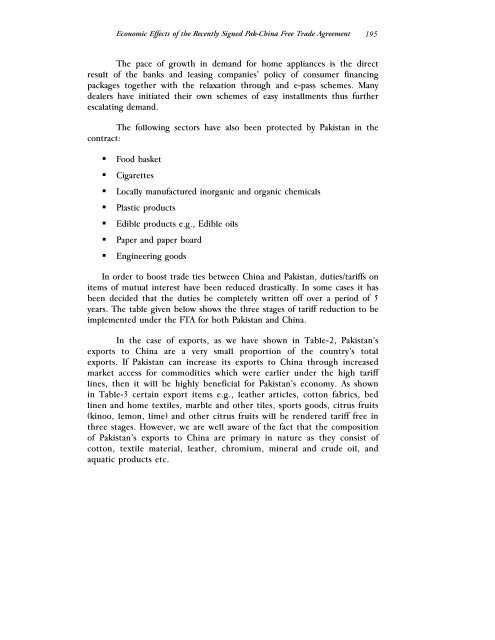Special Edition-07.pdf - Lahore School of Economics
Special Edition-07.pdf - Lahore School of Economics
Special Edition-07.pdf - Lahore School of Economics
You also want an ePaper? Increase the reach of your titles
YUMPU automatically turns print PDFs into web optimized ePapers that Google loves.
Economic Effects <strong>of</strong> the Recently Signed Pak-China Free Trade Agreement 195<br />
The pace <strong>of</strong> growth in demand for home appliances is the direct<br />
result <strong>of</strong> the banks and leasing companies’ policy <strong>of</strong> consumer financing<br />
packages together with the relaxation through and e-pass schemes. Many<br />
dealers have initiated their own schemes <strong>of</strong> easy installments thus further<br />
escalating demand.<br />
The following sectors have also been protected by Pakistan in the<br />
contract:<br />
• Food basket<br />
• Cigarettes<br />
• Locally manufactured inorganic and organic chemicals<br />
• Plastic products<br />
• Edible products e.g., Edible oils<br />
• Paper and paper board<br />
• Engineering goods<br />
In order to boost trade ties between China and Pakistan, duties/tariffs on<br />
items <strong>of</strong> mutual interest have been reduced drastically. In some cases it has<br />
been decided that the duties be completely written <strong>of</strong>f over a period <strong>of</strong> 5<br />
years. The table given below shows the three stages <strong>of</strong> tariff reduction to be<br />
implemented under the FTA for both Pakistan and China.<br />
In the case <strong>of</strong> exports, as we have shown in Table-2, Pakistan’s<br />
exports to China are a very small proportion <strong>of</strong> the country’s total<br />
exports. If Pakistan can increase its exports to China through increased<br />
market access for commodities which were earlier under the high tariff<br />
lines, then it will be highly beneficial for Pakistan’s economy. As shown<br />
in Table-3 certain export items e.g., leather articles, cotton fabrics, bed<br />
linen and home textiles, marble and other tiles, sports goods, citrus fruits<br />
(kinoo, lemon, lime) and other citrus fruits will be rendered tariff free in<br />
three stages. However, we are well aware <strong>of</strong> the fact that the composition<br />
<strong>of</strong> Pakistan’s exports to China are primary in nature as they consist <strong>of</strong><br />
cotton, textile material, leather, chromium, mineral and crude oil, and<br />
aquatic products etc.

















